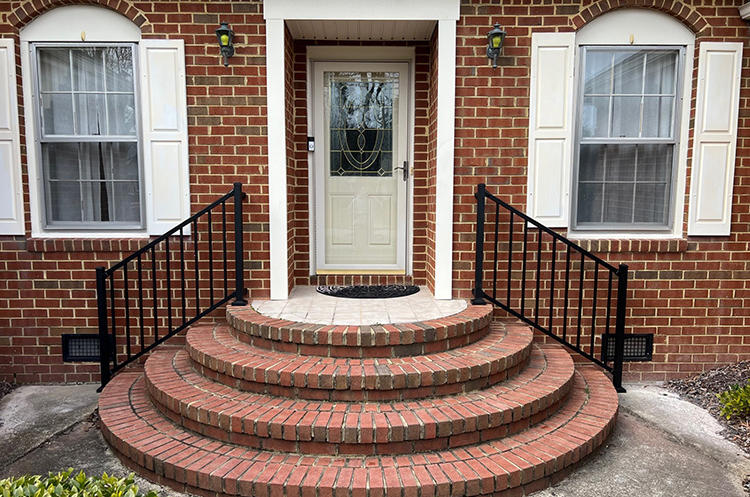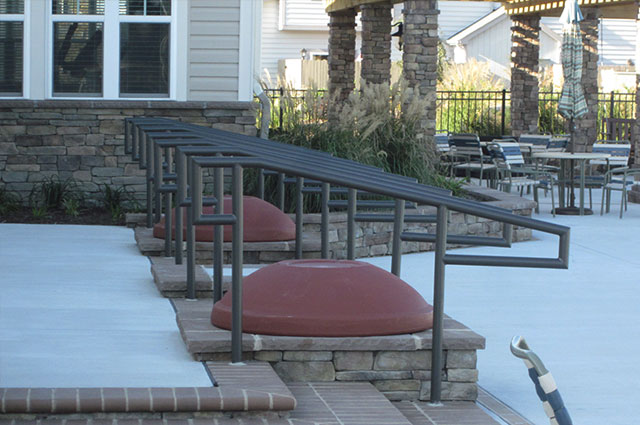Installation & Repair
Commercial Fencing
Railing
Stair Railings: An In-Depth Guide for Residential and Commercial Properties
Did you know that stair railings and even fencing in general could increase the value of a property? It might sound strange that something like stair railings could boost property value, considering that stairs should typically come with railings for safety, but, they can. From deciding on the right wood newels to best anchor your handrails to ensuring you’re up to code with the placement of each component, there’s a lot involved with proper stair rail installations. There is a lot that goes into picking the right type of railings, installing them, and how to best sustain them to sustain or even extend their lifespan. There are some options that complement certain designs more than others. There are also materials that work great for both residential and commercial properties. To get a better idea of whether you are on the wrong or right path with your project, keep reading to form a deep understanding of stair railings for multiple applications.
What Materials Make Good Stair Railings?
The type of railing materials you use should be based on a few key things concerning your overall handrail installation project. First, consider ADA compliance and any necessary building codes associated with what you are trying to do. For example, consider whether this will be a residential or commercial project because the handrail regulations are likely to be different. Typically speaking, for a residential project, a building code may specify to have anywhere from 34 to 38 inches for your handrail height. When it comes to the maximum projection of the railing coming out from the wall, you are likely to need 3 inches of space. There will also be differences when it comes to the distance between each railing and the hand clearance needed from the wall. It will all depend on the type of project, the material, and the property. So, checking that you’re in line with compliance would be the best place to start. Additionally, before deciding on material, you should determine the staircase design and aesthetic appeal you want to have. This will help narrow down the choices and make the decision simpler. With that, you also want to consider the level of durability and longevity you want to achieve. The cost and potential maintenance needs should be an additional thought.
Read More
Making Material Choices
There is a variety of materials that could be used for the type of railing that would best suit your project. Aluminum, Composite, and vinyl are three of the most popular. These options offer great design flexibility. material such as steel, for example, is a good option for both residential and commercial applications. Steel can be used for railings and handrail installations and offers a high durability rating. Wrought iron is another popular material and its popularity comes from its unmatched strength and simple installation process. It requires little maintenance and it withstands great results against time.
Base Your Choice on Style
When you’re having a hard time making your decision based on material alone, consider the design you hope to achieve. If you are going for more of a modern aesthetic, you should consider what options make for the best modern stair railing. With a modern staircase, some of the top options are:
- Steel (inside/out of the weather)
- Vinyl
- Aluminum
- Composite
These choices are very common material options and they offer affordability as well. If you want to stick with a budget while still favoring durability, aluminum, and steel are going to be superior choices. Keep in mind though that you can adjust just about any material to complement modern style. So, using wood newels and wood newel posts are still valuable options. While wood handrails are an older material used for these applications, it never actually gets old. Wood stair railings are easy to customize to your taste and they hold different hues of stain and paint well. This level of customization is something you will often get with other materials.
Where Can I Find Rails for My Stairs?
Certain materials have different grip types and offer an elevated level of safety. For example, steel is considered to be one of the safest materials to use for stair railings. This has a lot to do with its high level of durability. Even using mild steel is a good way to enhance the safety of your staircase. Whether you want to do it yourself or have a professional service install the railings for you, the best place to get the rails for your stairs would be an experienced supplier.Chesapeake Fence & Awning Co. offers both residential and commercial railings. What makes this option beneficial is that you get free estimates and professional installation, or you can have the materials provided to you if you prefer to do it on your own. This eliminates the instance of guesswork when it comes to pricing or the installation process. We do not recommend trying to DIY welded railing.
Frequently Asked
When Should I Consider Replacing My Stair Railings?
Determining when you should replace your stair railings should be gauged on a few things that are bringing the integrity of the railings into question. Consider how much maintenance it takes to keep your railings in good shape. Are you having to replace sections of the handrails often? Are you having to refrain from putting a certain amount of weight on them? If so, these are all reasons to consider calling a professional for railing replacement services. If your railings are unsteady or wobbly, or there is visible evidence of rusting or rotting material, these are other factors to consider. Keep in mind that minor rust won’t always call for the need for a full replacement. In some cases, you could simply force remove loose rust and paint over it, although this will call for a bit of prep work. Overall, though, even with minor rust, you may still need a minor repair. If the rust is significant, a full replacement may be the smartest option. Something as small as rust could be a tell-tale sign of potential structural damage. This can later turn into a significant problem because brittle railing means that the chance of it breaking is high. This causes security and personal safety hazards, so if the rust or general visual damage is significant enough, replace it. Also, you want to determine if there are any missing stair parts from your stair rails. Are there any missing spindles or are the iron balusters damaged in general? Missing or broken parts of the railings could pose fall hazards, which is another reason why a replacement might be necessary.
What Different Types of Stair Railings Are There?
There are two primary options for railings which are handrails and guardrails. Guardrails are meant to enhance the safety and general protection of people who will be using elevated means of movement. This could mean an elevated platform or deck. Guardrails are used for a lot more than stairs and this is the main difference between the two. A handrail is actually meant to be grasped and is a direct hand-holding device. It’s a transitional piece that helps people move from one elevated space to another. It offers stability and is meant to be used as a guide. When it comes to different types of stair railings specifically, there are multiple options that can be used to enhance different styles and designs. These options will range from different types of wood, metals, and glass. You can also use balusters, which are generally freestanding. Or, you could go with a traditional railing, which simply means that it will be attached to the wall. What you decide on in terms of railing materials and placement should be based on your layout and the design you hope to achieve as your end result.
How Long Does It Typically Take?
Stair railing installation doesn’t take up much time. A lot of these installation projects don’t take longer than three weeks from the start of the project. This does not include wait time for obtaining the materials. In general, a lot of these applications will take anywhere from one to three weeks. For simpler installations, it’s possible that the job could be done in more than three days. The true length of the project will depend on the material, the space, and the design.
Regulations for Stair Railings in Residential and Commercial
To determine the material you need and how much, professionals will take a look at a few things. They will assess the measurement of the overall height that’s needed. The length, length of the nosing, as well as the height and depth of the finished tread will be taken into account. These things will also vary by the type of staircase you have and the complexity of the project. In general, what’s needed for the project will differ based on whether it’s a residential or commercial application.
Residential Regulations Overview
For residential projects, you will notice rules that mention things like not having the stair run less than one foot beyond the above riser. You may also notice that every flight of stairs with four or more risers should have a railing on at least one side. Handrail heights still won’t usually be less than 34 inches, and all heights will be measured from the nose of every step. For safety purposes, regulations will seem similar to each other but will vary based on the type of property or facility.
Commercial Regulations Overview
Keep in mind that handrail codes will often vary by your state. In general, for commercial applications, OSHA requires a stair rail system to be at least 42 inches in height. In Virginia specifically, the maximum height for handrails will range from 34 to 38 inches from the nosing of the treading. A lot of the time, you will notice that many state regulations are uniform, although they can vary.
A Look at the Installation Process
There usually aren’t more than six steps in the installation process. The process will start by locating and marking studs for the handrail location. The handrails will usually then be cut to your desired length and the height of each rail will be made for guide purposes.
The rest of the process will proceed like this:
- Making marks for the bracket locations
- Attaching the brackets to the wall along the staircase
- Attaching the actual stair railings to the installed brackets
Some steps that might follow after the installation process would be safety and quality checks. Quality is usually an initial step when deciding on the material to be used. However, this is also done post-installation to ensure the quality of the actual job is up to par with the client.
Making Handrail Installation and Implementing Wood Newels Simple
Handrail installations don’t have to be complex and the process also doesn’t have to take up much time. Quality stair rails offer enhanced safety, and stability for residents or those that use a building, and they are essential for any complete structure with elevated levels.
Whether you’re using wood newels or newel posts to remove design limitations or you prefer to work with wrought iron to try something new, multiple options can enhance any design preference. To get started with your commercial or residential project, get in touch with Chesapeake Fence & Awning Co. today.



